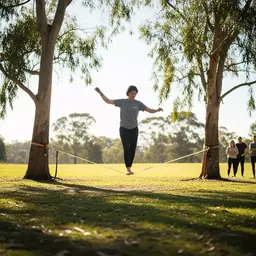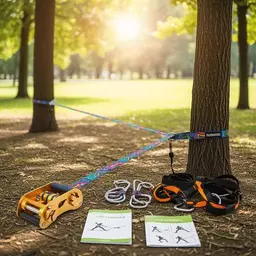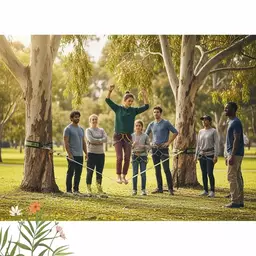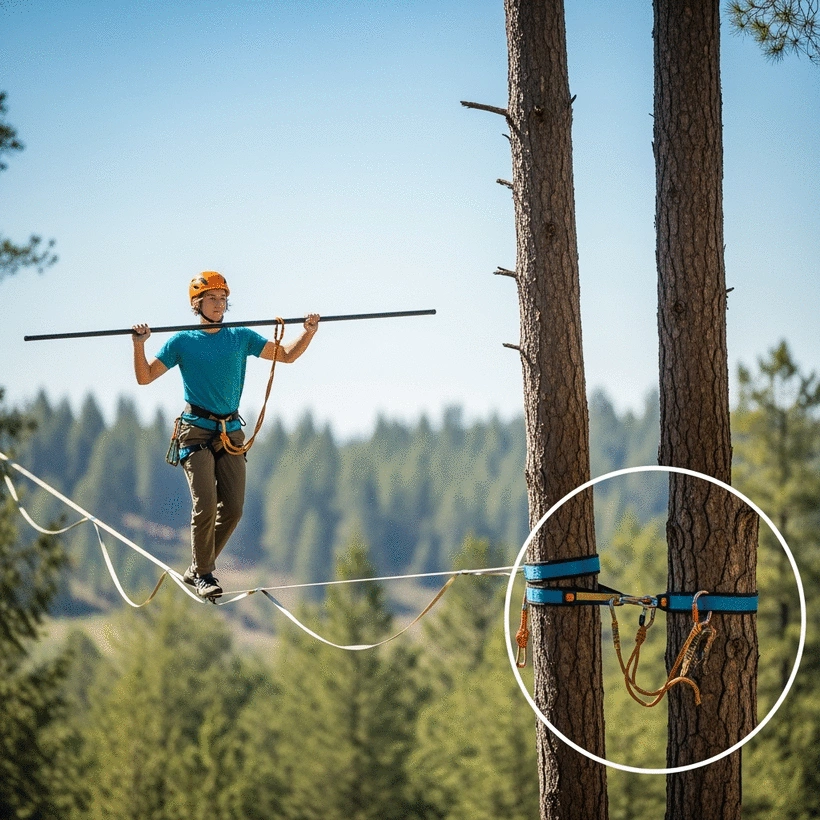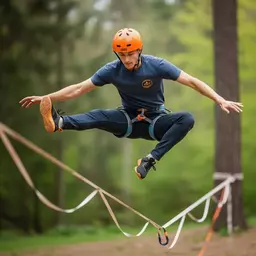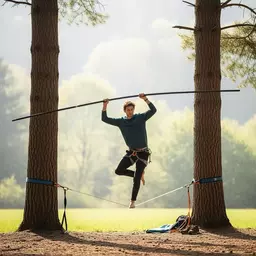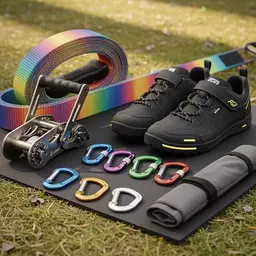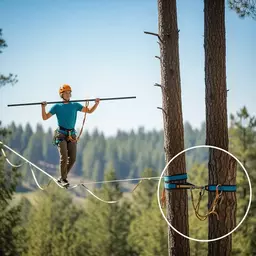Choosing the Right Slackline Setup
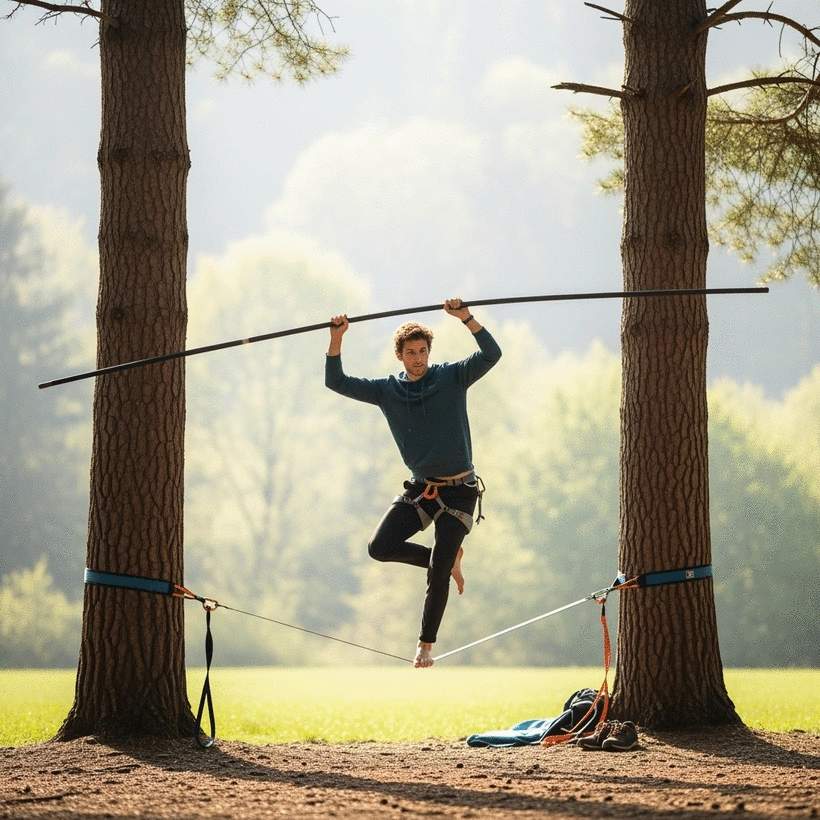
When you embark on your slacklining journey, understanding your unique needs is crucial for success. From selecting the right gear based on your skill level to evaluating your setup space, there’s much to consider. Here’s a breakdown of key insights that will empower your slacklining experience!
What You Will Learn
- Identifying your skill level helps in choosing the right slackline for beginners, intermediates, and advanced users.
- Evaluate your setup space, ensuring at least 10-20 feet between anchor points for optimal performance.
- Essential accessories such as tree protectors and ratchets enhance safety and usability during slacklining.
- Understanding materials like polyester and nylon can significantly affect your slackline's performance and feel.
- Selecting an appropriate tensioning system is vital for safety and functionality in your slacklining setup.
Understanding Slackline Selection Factors
When selecting a slackline, key considerations include your skill level and the specific features of the equipment. The visual below highlights how these factors influence your choice. For a comprehensive guide on getting started, check out our beginners guide to slackline kits.
Skill Level vs. Slackline Width
Material Impact on Performance
Choose based on your goals and desired feel.
Understanding Your Slackline Needs
When starting your slacklining journey, the first step is to understand your specific needs. Slacklining is not a one-size-fits-all sport; it varies significantly based on your skill level, setup space, and personal preferences. By evaluating what you require, you can ensure that your gear matches your ambitions. Let's break it down!
Evaluating Your Skill Level: Beginner, Intermediate, or Advanced
Your skill level will greatly influence the type of slackline you choose. As a beginner, you might want to start with a wider and more forgiving line, typically around 15 to 30 meters in length. This helps with maintaining balance and building confidence. Here are some options that suit each skill level:
- Beginners: Look for a slackline with a width of 2 inches for stability.
- Intermediate: A 1.5-inch wide line between 30-50 meters will challenge your balance while still being manageable.
- Advanced: If you're seasoned, you might prefer a 1-inch line that’s longer than 50 meters for precision and trick-based activities.
As you progress, you’ll discover what works best for you. It’s all about finding that perfect balance between challenge and comfort! If you're looking for more guidance on specific slackline balance techniques, explore our detailed guide.
Identifying Your Setup Space and Requirements
Next, let's assess your slacklining setup area. You'll want to consider factors like tree distance and the weight of your gear. A good setup should have at least 10-20 feet between your anchor points (like trees or poles) for a comfortable line length. Here are some tips for evaluating your space:
- Ensure the ground is soft—grass or sand is ideal to prevent injuries.
- Check that your anchor points are sturdy and at least 10 feet apart.
- Consider the portability of your gear if you plan to set up in multiple locations.
By taking the time to evaluate your space, you can avoid pitfalls and enjoy a smoother slacklining experience. Remember, a well-chosen location makes all the difference in your practice!
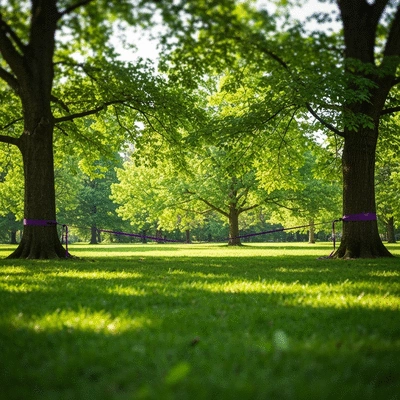
Key Features to Consider in a Slackline
Once you understand your needs, it’s time to dive into the features that will enhance your slacklining experience. There are several key components to consider when selecting gear!
Essential Accessories for Your Slackline Kit
Accessories play a crucial role in your slacklining setup. They can enhance safety, ease of use, and longevity of your gear. Here are some essentials you shouldn't skip:
- Tree Protectors: These prevent damage to the bark and ensure a secure setup.
- Ratchets: A good ratchet system will allow you to easily tension the slackline and keep it taut.
- Carry Bags: Opt for a durable bag that can hold all your gear for easy transport.
Investing in quality accessories can save you from headaches later on. Plus, it will give you peace of mind while you focus on mastering your balance!
Understanding Slackline Materials and Their Impact on Performance
The materials used in slacklines significantly affect their performance and feel. Most lines are made from either polyester or nylon, and here's how they differ:
- Polyester: Offers excellent durability and minimal stretch, making it great for tricklining.
- Nylon: Provides more stretch and a softer feel, which is ideal for beginners learning balance.
Choose wisely based on your goals; understanding these materials will help you pick a slackline that aligns with your adventure pursuits.
Exploring Tensioning Systems and Their Role in Slackline Setup
The tensioning system is essential for ensuring your slackline is both safe and functional. Whether you’re using a ratchet or a pulley system, here are some key points to consider:
- Ease of Use: Look for systems that are straightforward, especially if you're just starting out.
- Safety Features: Check for locking mechanisms that prevent accidental release.
- Weight and Portability: Ensure it’s light enough for easy transport if you plan to set up in various locations.
Ultimately, the right tensioning system helps maintain a safe environment while enhancing your performance. It’s all part of the fun! To learn more about setting up your slackline safely, read our guide on slackline safety setup.
Pro Tip
When selecting your slackline, consider trying out different setups before making a final choice. Visiting local slackline meetups or workshops can give you hands-on experience with various types of lines and tensioning systems. This not only helps in understanding your preferences but also connects you with the community for shared tips and support!
Summarizing Key Insights on Slackline Selection
Choosing the right slackline isn't just a matter of picking a random product off the shelf. Understanding your skill level is essential, as it directly influences the type of slackline you'll want to invest in. If you’re a beginner, shorter and less tensioned lines can help you gain confidence without feeling overwhelmed. Intermediate and advanced slackliners typically seek longer lines with more tension for greater challenge and versatility.
Additionally, evaluating your setup space is crucial. Consider the distance between trees or anchor points, and whether you're using a portable setup or a more permanent installation. Lastly, the key features to consider, including materials and tensioning systems, enhance your slacklining experience and ensure safety. As you proceed, keep these elements in mind!
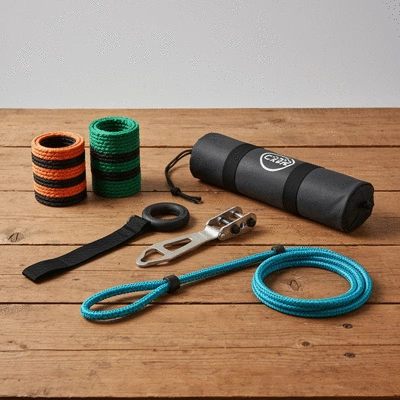
Frequently Asked Questions (FAQs)
Q1: How do I choose the right slackline width for my skill level?
A1: Beginners should opt for a 2-inch width for better stability. Intermediate users can challenge themselves with a 1.5-inch width, while advanced slackliners often prefer a 1-inch width for precision and trick-based activities.
Q2: What's the ideal distance between anchor points for a slackline?
A2: For a comfortable and optimal setup, you should aim for at least 10-20 feet between your anchor points, such as trees or sturdy poles.
Q3: Why are tree protectors important for slacklining?
A3: Tree protectors are crucial for two main reasons: they prevent damage to the tree bark, ensuring environmental responsibility, and they protect your slackline from abrasion, prolonging its lifespan and ensuring a secure setup.
Q4: What's the difference between polyester and nylon slacklines?
A4: Polyester slacklines offer excellent durability and minimal stretch, making them ideal for tricklining. Nylon slacklines provide more stretch and a softer feel, which is often preferred by beginners for learning balance.
Q5: What should I look for in a slackline tensioning system?
A5: When choosing a tensioning system, prioritize ease of use, especially if you're a beginner. Also, ensure it has reliable safety features like locking mechanisms to prevent accidental release, and consider its weight and portability if you plan to set up in various locations.
Encouraging Further Exploration and Engagement
We’d love to hear from you! What are your thoughts on slackline selection? Have you found a specific setup that works wonders for you? Share your experiences or questions in the comments below! Engaging with our community can help you gain insights tailored to your unique situation and needs.
Remember, each slacklining journey is personal, and what works for one person may not suit another. As you consider purchasing your slackline, think about your skill level, setup requirements, and the specific features that will best support your adventure. The more informed you are, the more enjoyable your slacklining experience will be!
Exploring the Slackline Community and Events
The slackline community is vibrant and full of opportunities to enhance your skills. Participating in workshops and competitions can provide you with invaluable experiences and insights from fellow enthusiasts. Not only do these events sharpen your skills, but they also foster camaraderie and create lasting friendships among slackliners of all levels.
- Workshops: Great for learning new techniques and getting tips from experts.
- Competitions: A fun way to challenge yourself and meet like-minded individuals.
- Local Slackline Groups: Connect with others in your area to practice and share knowledge.
So, why not dive into this amazing community? Embracing these opportunities will not only elevate your skills but also enrich your overall slacklining experience. Join us at Slackline Shop Australia as we celebrate the joy of balance and adventure together! For more community insights, check out engaging with Australia's slackline community.
Recap of Key Points
Here is a quick recap of the important points discussed in the article:
- Skill Level: Choose slacklines based on your skill level; beginners should opt for wider lines, while advanced users can handle narrower, longer lines.
- Setup Space: Ensure at least 10-20 feet between anchor points and choose soft ground like grass or sand for safety.
- Essential Accessories: Invest in tree protectors, ratchets, and carry bags to enhance safety and convenience.
- Material Choice: Understand the difference between polyester and nylon for optimal performance based on your goals.
- Tensioning Systems: Look for user-friendly systems with safety features to maintain stability and ease of setup.
